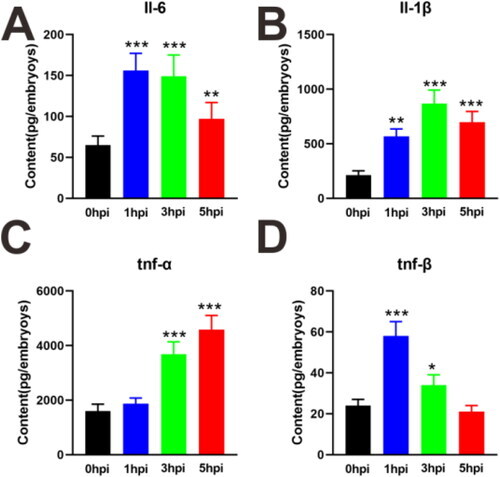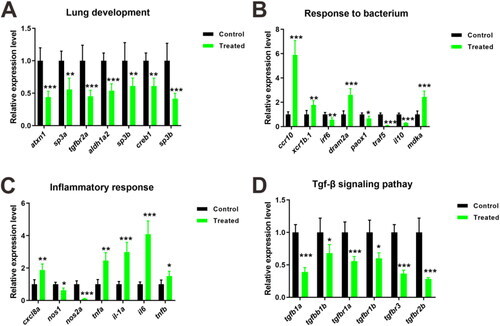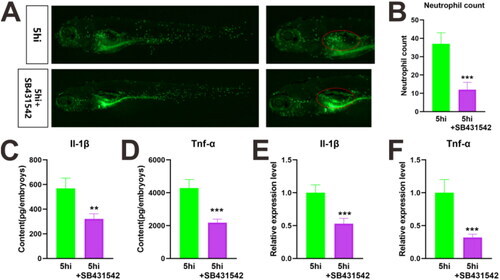- Title
-
Zebrafish as a model for investigating Klebsiella pneumoniae-driven lung injury and therapeutic targets
- Authors
- Ye, J., Lu, L., Rui, X.H., Ren, M.D., Tu, F., Shang, Z.B., Liu, J.
- Source
- Full text @ Exp. Lung Res.
|
Neutrophil migration in the zebrafish lung injury model induced by Klebsiella pneumoniae. (A) The migration of neutrophils to the infection site following the injection of Klebsiella pneumoniae into the zebrafish swim bladder. (B) Quantitative analysis of neutrophil migration at different time points (1, 3, and 5 hours). Statistical analysis using Student’s t-test reveals a significant increase in neutrophil migration in the infection group (p < 0.01). Data are presented as mean ± standard deviation (n = 10). |
|
Elevated cytokine secretion in the zebrafish lung injury model induced by Klebsiella pneumoniae. (A–D) The secretion levels of IL-6 (A), IL-1β (B), TNF-α (C), and TNF-β (D) significantly increased at 1, 3, and 5 hours post-infection. ANOVA analysis, followed by Tukey’s multiple comparison test, confirmed statistically significant differences between groups (p < 0.05). Data are presented as mean ± standard deviation (n = 3). |
|
Key signaling pathways revealed by transcriptomic analysis of Klebsiella pneumoniae-induced lung injury in zebrafish. (A) Changes in the number of differentially expressed genes (DEGs). Genes with significant upregulation and downregulation were identified using edgeR analysis (FDR < 0.05). (B) GO enrichment analysis highlighted key biological processes, including liver morphogenesis, extracellular matrix remodeling, response to bacterial infection, lung development, chronic inflammation, and CXCR cytokine receptor binding. Fisher’s exact test was used for enrichment analysis, with p < 0.05 considered significant. (C) KEGG enrichment analysis identified significant enrichment in several key signaling pathways, including the Toll-like receptor pathway, MAPK signaling pathway, TGF-β signaling pathway, PPAR signaling pathway, cytoskeletal regulation, and phagosome pathway. Statistical analysis was performed using Fisher’s exact test (p < 0.05). |
|
qRT-PCR validation of gene expression changes in Klebsiella pneumoniae-induced zebrafish lung injury. (A) Validation of expression changes in lung development-related genes. (B) Validation of expression levels of genes involved in bacterial response. (C) Validation of expression changes in inflammation-related genes after infection. (D) Validation of expression levels of genes associated with the TGF-β signaling pathway. Relative expression levels were calculated using the ΔΔCt method, with data presented as mean ± standard deviation (n = 3). Statistical significance was determined using Student’s t-test (p < 0.05). |
|
TGF-β pathway inhibitor SB 431542 mitigates Klebsiella pneumoniae-induced lung injury in zebrafish. (A) TGF-β inhibitor SB 431542 significantly reduced neutrophil aggregation induced by K. pneumoniae infection. (B) The number of neutrophils in the SB 431542-treated group was significantly lower than in the infection group (p < 0.05, Student’s t-test). (C–D) The concentrations of IL-1β (C) and TNF-α (D) cytokines were significantly reduced following SB 431542 treatment (p < 0.05, Student’s t-test). (E–F) qRT-PCR validation showed that IL-1β (E) and TNF-α (F) gene expression levels were significantly downregulated in the SB 431542-treated group (p < 0.01, Student’s t-test). |





